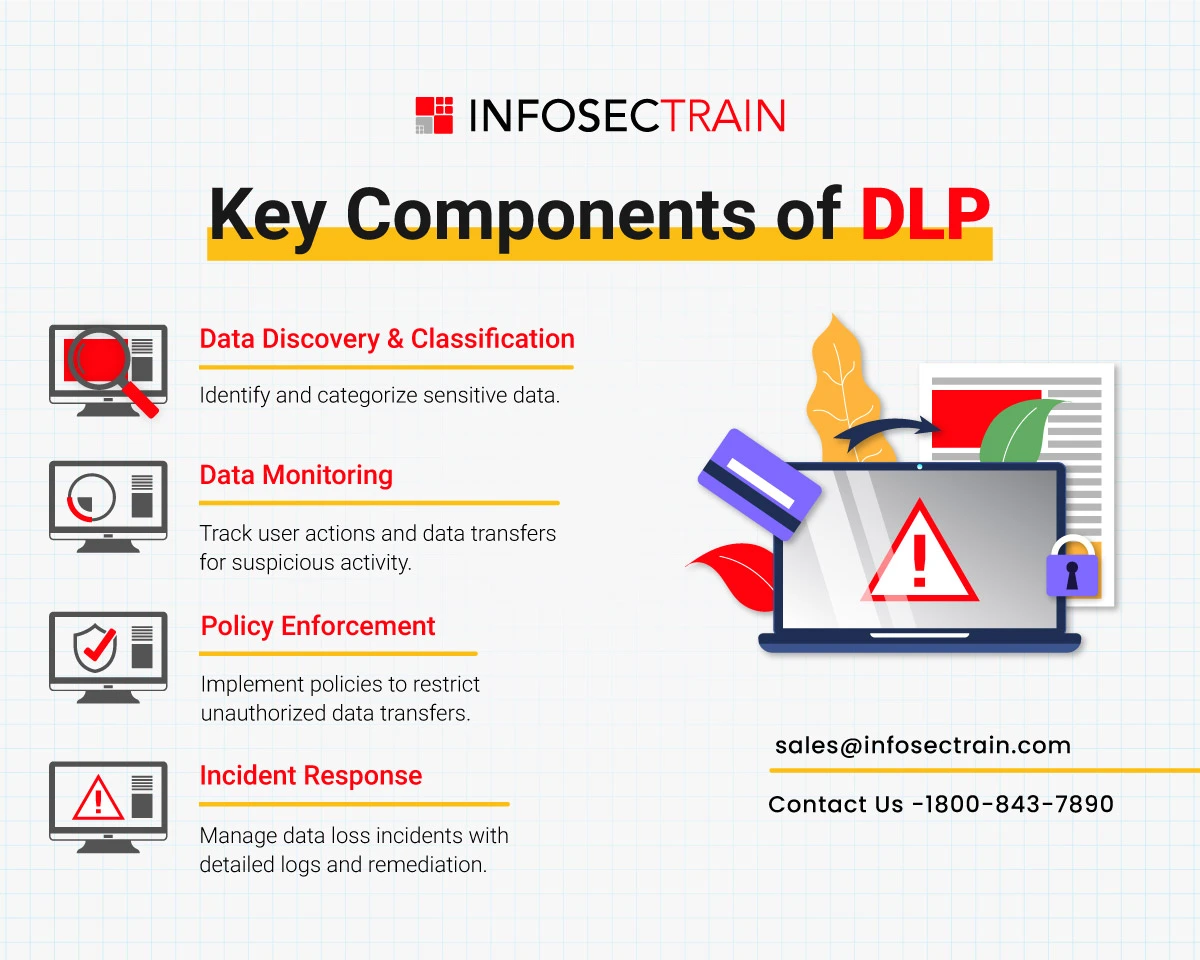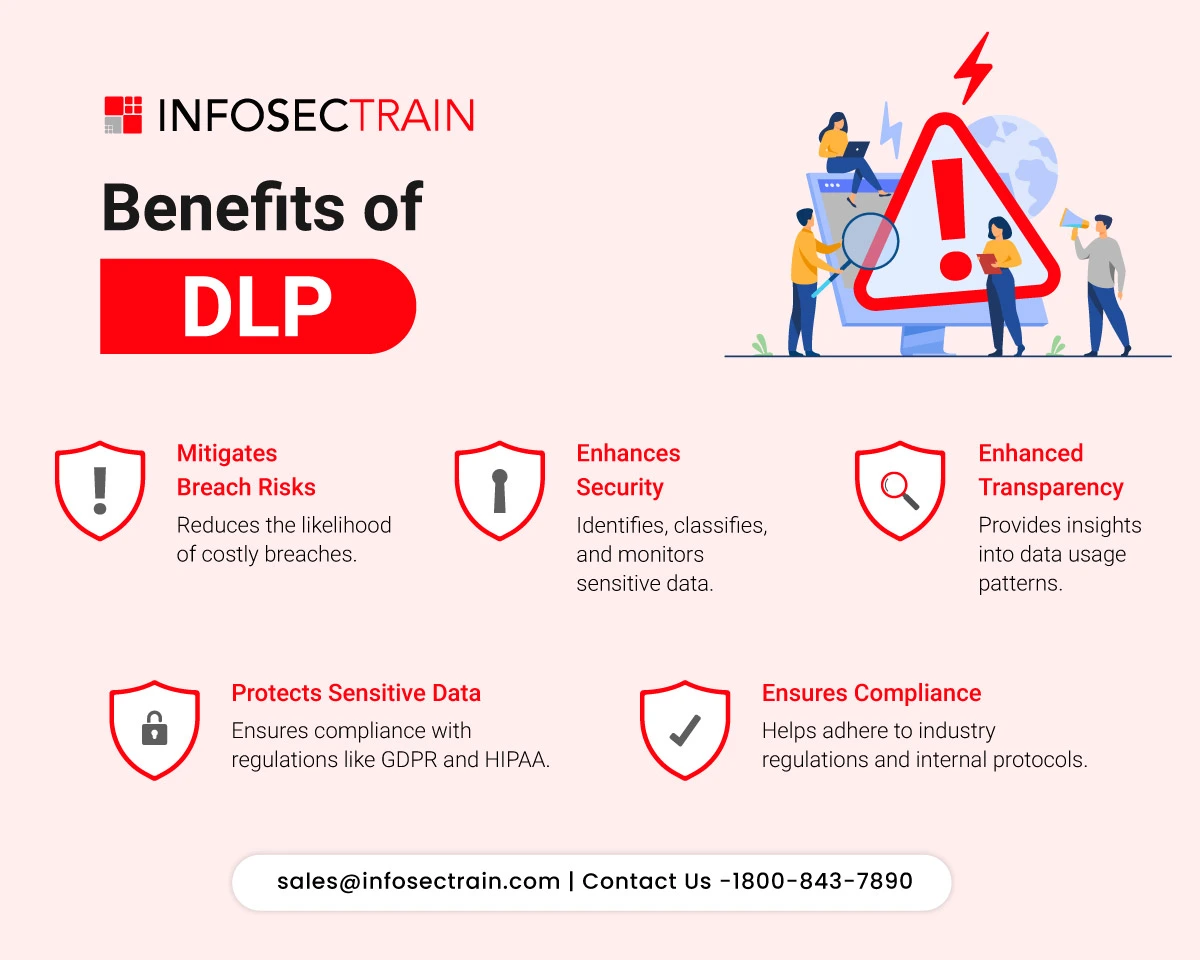Data Loss Prevention (DLP)
Data Loss Prevention is crucial in our digital era, where businesses and individuals regularly create and exchange large volumes of data. While this data is essential for driving innovation and efficiency, it poses significant risks if unauthorized parties access it. Therefore, DLP is pivotal in protecting sensitive information and minimizing potential threats. DLP solutions are crafted to detect, monitor, and safeguard sensitive data, ensuring adherence to regulatory standards and diminishing the probability of data breaches. By implementing robust DLP measures, organizations can protect their reputation, maintain customer trust, and mitigate financial losses associated with data compromise.

Table of Contents
What is Data Loss Prevention (DLP)?
Key Components of DLP
Benefits of DLP
Cybersecurity Training with InfosecTrain
What is Data Loss Prevention (DLP)?
Data Loss Prevention (DLP) is a comprehensive approach to safeguarding sensitive data from unauthorized access, disclosure, or theft. It involves deploying technologies, policies, and procedures to monitor, detect, and protect data throughout its lifecycle. DLP solutions identify and classify sensitive information, enforce data protection policies, and enable real-time monitoring to prevent data leakage. DLP implementation allows organizations to ensure regulatory compliance, minimize the probability of data breaches and protect valuable data assets.
Key Components of DLP

1. Data Discovery and Classification:
DLP initially entails identifying sensitive data within the organization’s network and categorizing it according to sensitivity and importance levels. Utilizing automated scanning and tagging features, DLP solutions can identify sensitive information, including Personally Identifiable Information (PII), financial records, intellectual property, and confidential documents.
2. Data Monitoring and Activity Tracking:
In DLP, user actions and data transfers are constantly monitored to identify suspicious activity that could suggest a possible data breach. This encompasses actions like unauthorized attempts to transfer sensitive data to unapproved devices, the transmission of significant data quantities through email, or irregular access behaviors to sensitive information.
3. Policy Enforcement:
DLP implements established policies to safeguard against data loss, including restricting unauthorized data transfers, securing sensitive data through encryption, or requiring users to provide reasons for transferring sensitive information.
4. Incident Response:
DLP assists in managing data loss incidents by offering detailed logs and insights into breach occurrences. Such information facilitates swift containment and remediation actions, aiding in mitigating the breach’s impact and minimizing potential damages.
Benefits of DLP

1. Protects Sensitive Data: DLP ensures compliance with data privacy regulations such as GDPR or HIPAA by safeguarding sensitive information. This includes implementing measures to detect, monitor, and protect sensitive data, ensuring organizations attain regulatory compliance while minimizing the risk of data breaches.
2. Enhances Data Security: DLP enhances your overall data security stance by providing additional protection for sensitive information. This includes implementing measures to identify and classify sensitive data, enforce data protection policies, and monitor data usage to prevent unauthorized access or leakage, ultimately reducing the risk of data breaches.
3. Mitigates Data Breach Risks: DLP reduces the likelihood of costly data breaches by monitoring and preventing data leaks. This involves employing technologies and policies to detect and respond to unauthorized access or transmission of sensitive data, safeguarding valuable information assets, and protecting against financial and reputational damage associated with data breaches.
4. Ensures Regulatory Compliance: DLP assists organizations in adhering to industry regulations and internal data security protocols. This involves implementing measures to identify and classify sensitive data, enforce compliance with regulatory requirements, and maintain audit trails to demonstrate adherence to data protection standards. DLP helps organizations avoid regulatory penalties and reputational harm associated with non-compliance by ensuring compliance.
5. Enhanced Data Transparency: DLP solutions offer valuable visibility into data usage patterns within your organization. This includes providing insights into how data is accessed, shared, and utilized across various systems and applications. DLP enables organizations to understand and manage their data assets better, identify potential risks, and optimize data protection strategies to safeguard sensitive information by enhancing data visibility.
Cybersecurity Training with InfosecTrain
Infosectrain offers comprehensive Cybersecurity training led by experts, equipping individuals with the essential knowledge and skills to safeguard their online presence and navigate the digital landscape securely. Whether a cybersecurity professional or an average internet user, grasping cybersecurity fundamentals is vital for informed decision-making and online safety. In today’s digitally driven world, maintaining vigilance and giving precedence to cybersecurity is paramount. At InfosecTrain, we prioritize empowering individuals with practical strategies to defend against cyber attacks and safeguard sensitive information effectively.







 1800-843-7890 (India)
1800-843-7890 (India)